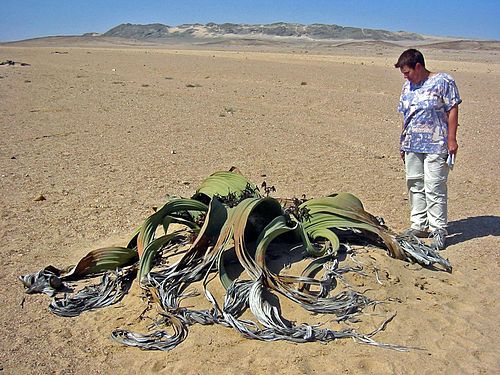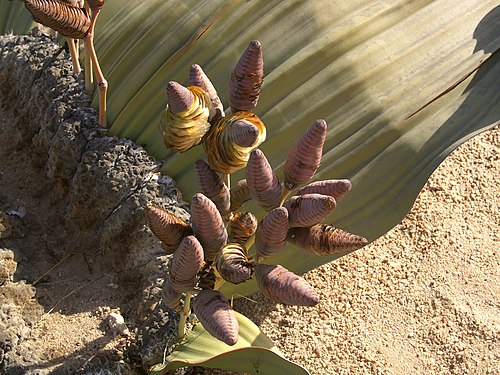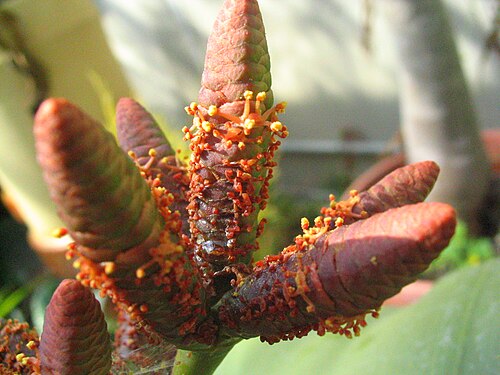Welwitschia mirabilis
| Height: | ⇕ | 1.4 m"m" can not be assigned to a declared number type with value 1.4. |
|---|---|---|
| Width: | ⇔ | 4 m"m" can not be assigned to a declared number type with value 4. |
| Lifespan: | ⌛ | perennial |
| Origin: | ✈ | Namibia, Angola |
Ancient plant that can live over 1,000 years. Only grows two leaves, which may split as it grows.
Read about Welwitschia mirabilis in the Standard Cyclopedia of Horticulture
|
|---|
|
Welwitschia mirabilis, Hook. f. Lvs. 6 ft. or more long, the split ends reclining on the ground, flat and long-narrow, attached at the base to the crown of the wrinkled brown and hard trunk: plant said to persist a century. G.C. III.47:56. J.H. III.46:38. G.W. 9, pp. 294-5.
|
Read about Welwitschia mirabilis in the Standard Cyclopedia of Horticulture
|
|---|
|
Welwitschia (Dr. Friedrich Welwitsch, 1806-1872, botanical traveler, who brought this remarkable plant to notice). Gnetaceae. One of the most singular of plants, sometimes seen in the dried state in museums and rarely grown in botanic gardens. The plant consists essentially of 2 persistent woody lvs. lying near or on the ground, the ends becoming much frayed (at one time supposed to be persistent cotyledons), and from the center or crown the cone-like fructification arises. It may be described as follows: A low woody plant, sometimes grown as an oddity: st. or trunk thick, cone- or top-shaped, usually somewhat raised above ground, more or less 2-lobed, said to be sometimes 14 ft. in circum.: lvs. 2, lasting the life of the plant, linear at first, later splitting into many sections: infl. axillary, paniculate, dichotomously branched, the branches ending in 4- angled ament-like spikes which are colored: fls. dioecious; male fls. with 4 perianth-segms. in the shape of a cross, stamens 6, joined at the base, seed sterile; perianth of female fls. tubular, inclosing completely the fertile seed.—One species, arid places Trop. and S. W. Afr. The oldest actual name for this strange plant is Tumboa, which was mentioned incidentally in the Gardeners' Chronicle, 1861, page 75, in a running account of a meeting of the Linnean Society; and the name T. Bainesii, Hook, f., was similarly mentioned on page 1008 in an account of a meeting of the Royal Horticultural Society. In the same journal in 1862 the name T. strobilifera was also mentioned. Neither the genus nor the species was botanically defined. In Gardeners' Chronicle for 1862, the name Welwitschia was proposed, and under this name the characters were carefully drawn and the plant regularly described in Trans. Linn. Soc., 1863, and in the same year in B.M. 5368, 5369. Under this name the plant has passed; but in Engler & Prantl, Pflanzenfamilien Nachtr. (1897), attention is called to the older Tumboa as the proper name, and this name is taken up in Cat. Welwitsch Afr., pl. II, pt. 1 (1899). All the preceding literature is under Welwitschia and all the horticultural references; and inasmuch as the aim in nomenclature is, or should be, stability rather than priority, the principle of long-accepted usage should be invoked in this case and the name Welwitschia retained, particularly as the name Tumboa was not formally founded and as the revival of it contributes nothing to clearness or definition. (It is retained by the Brussels Congress.) In respect to the cultivation of Welwitschia, W. Watson, Curator of the Royal Botanic Gardens, Kew, England, writes in 1916: "We have a plant here which was raised from a seed in 1880. It lives, but growth is very slow, so slow that a full-sized plant, such as we have in our Museum, might at this rate be reckoned a thousand years old. We grow it in a tropical house devoted to succulents, where it gets all the sunlight, the usual amount of water, except for about three months in winter, when it gets very little, and it is potted in sandy loam. There may be a set of conditions that would suit the plant better, though experiments with other plants raised here since did not reveal anything better.
|
Read about Welwitschia mirabilis in the Standard Cyclopedia of Horticulture
|
|---|
|
syn. Tumboa (native name). Gnetaceae. Applying strictly the rules of priority, T. Bainesii, Hook, f., becomes the name of the strange plant long known as Welwitschia mirabilis; in this work, the description is given under the latter name. CH
|
Cultivation
- Do you have cultivation info on this plant? Edit this section!
Propagation
The species grows readily from seed, which may be purchased from specialty seed dealerswp. Keep seeds moist for the first few weeks, giving as much heat and light as possible. Seeds from the wild are usually contaminated with spores of Aspergillus niger, causing them to rot soon after germination.
Pests and diseases
- Do you have pest and disease info on this plant? Edit this section!
Species
Gallery
If you have a photo of this plant, please upload it! Plus, there may be other photos available for you to add.
References
- Standard Cyclopedia of Horticulture, by L. H. Bailey, MacMillan Co., 1963
External links
- w:Welwitschia mirabilis. Some of the material on this page may be from Wikipedia, under the Creative Commons license.
- Welwitschia mirabilis QR Code (Size 50, 100, 200, 500)







